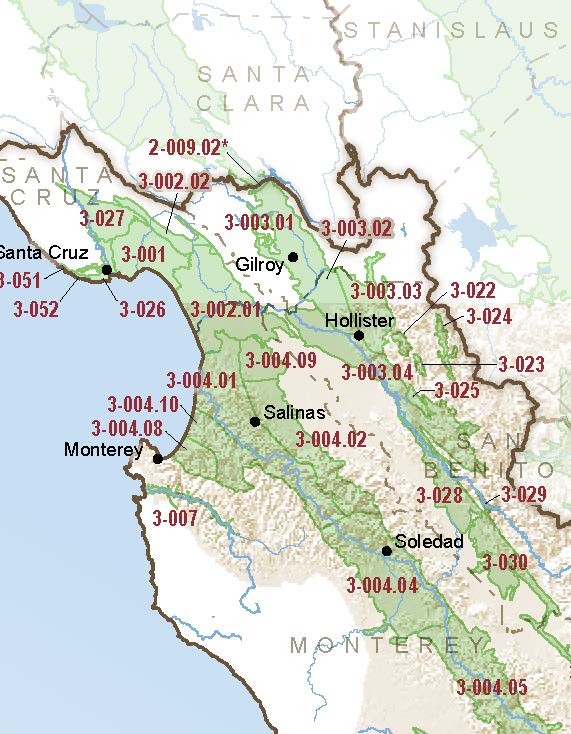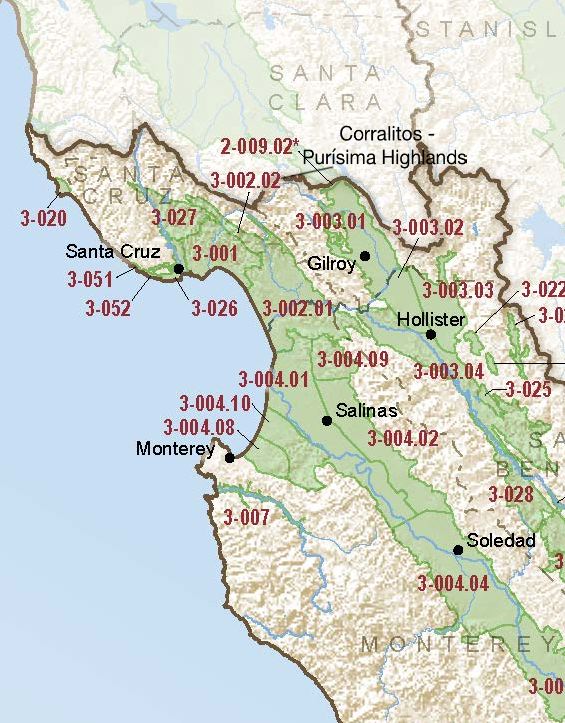Region: Central Coast
Gilroy-Hollister Valley – Hollister Area (now part of the North San Benito subbasin)
Corralitos – Purísima Highlands
KCBX Two-way: Groundwater in the Cuyama Valley
From KCBX:
“In 2014, state lawmakers passed the Sustainable Groundwater Management Act or SGMA. It changed everything about how groundwater will be used in the future. But will it work?
Jeremy P. Jacobs is a reporter for E&E News. That’s a non-partisan news service based in Washington DC. Jacobs is one of the news service’s California-based reporters. He recently took a close look at the Cuyama Valley, on the Central Coast. Jacobs wrote about what he found in an article that appeared in Greenwire, a publication of E&E News. His article is part of a series called “When The Wells Run Dry.”
KCBX News spoke with Jacobs about his reporting in the Cuyama Valley, and started by asking him how he got interested in groundwater—and in that particular place. … “
Future of Salinas Valley water set for community meetings
From the Monterey County Herald:
“With the future of Salinas Valley groundwater supply and usage hanging in the balance, residents of the farming-rich area known as the Salad Bowl of the World will get a chance to weigh in this week on how their water is managed under the state’s Groundwater Sustainability Act.
In a series of community meetings set for this week, the public will be given the opportunity to offer their opinions on the creation of a required groundwater sustainability plan that will govern how the valley’s water users including cities, agricultural interests, and others balance water usage and recharge, and how to pay for it, under the state legislation. … “
Continue reading at the Monterey County Herald by clicking here.
Thirsty vineyard, Big Ag test landmark aquifer law
From E&E News:
When Roberta Jaffe and her husband planted their small vineyard, one factor trumped all others: groundwater.
Knowing that this isolated valley in south-central California relies on a depleted aquifer, the couple “dry farmed” their Condor’s Hope Ranch, using 5 percent or less of the water required by a conventional vineyard.
“For us, it is very much about farming in a way that is harmonious with the environment,” Jaffe said. “This is what we see as what this environment can handle.”
So Jaffe was alarmed when Harvard University’s endowment fund installed an 850-acre conventional vineyard just down the road in 2014 — and drilled 14 wells.
Tres Pinos Valley
A New Groundwater Market Emerges in California. Are More on the Way?
From Water Deeply:
“A “use-it-or-lose-it” system of water allocation has historically required growers in California to irrigate their land or lose their water rights, whether market forces compelled them to grow crops or not.
Now, in a significant breakthrough for the state’s water economy, a community of farmers near Ventura are about to join a new groundwater market. The buying and trading system, expected to begin by July 1, will allow farmers under the purview of the Fox Canyon Groundwater Management Agency to fallow their own land and sell groundwater to other users willing to pay more than their crop sales would generate. This small-scale water market has been in planning stages for more than a year and is being launched as a pilot project that could eventually serve as a model for the rest of California. … “
Read more from Water Deeply here: A New Groundwater Market Emerges in California. Are More on the Way?
Sunshine, beaches and…saltwater intrusion? Solving for groundwater decline on California’s coast
From Christina Babbitt at the Growing Returns blog:
“For much of its history, California was the Wild West when it came to groundwater. Thirsty cities and farms could freely pump from underground aquifers with little to no oversight. If you could build a well you could take the water.
Recognizing the negative impacts of unchecked pumping, the state stepped in and, in 2014, passed the Sustainable Groundwater Management Act (SGMA). SGMA makes local agencies responsible for bringing priority groundwater basins into sustainability – meaning many water managers now need to find new ways to meet their water needs. … “
Read more from the Growing Returns blog by clicking here.
Stanford scientists map seawater threat to California Central Coast aquifers
From Stanford News:
“Researchers from Stanford and the University of Calgary have transformed pulses of electrical current sent 1,000 feet underground into a picture of where seawater has infiltrated freshwater aquifers along the Monterey Bay coastline.
The findings, which will be published in an upcoming issue of the Journal of Hydrology but are available online now, help explain factors controlling this phenomenon, called saltwater intrusion, and could help improve the groundwater models that local water managers use to make decisions about pumping groundwater to meet drinking or farming needs. … “
Read more from Stanford News here: Stanford scientists map seawater threat to California Central Coast aquifers




